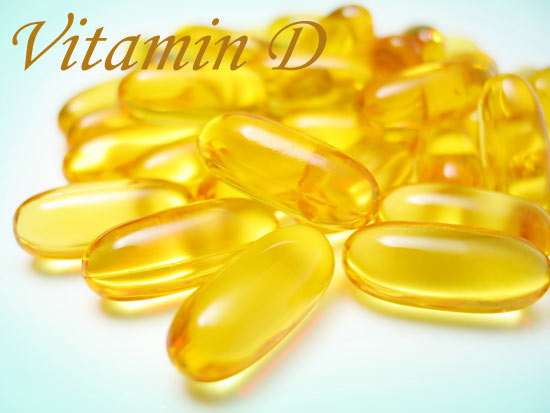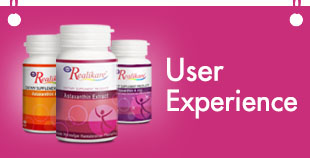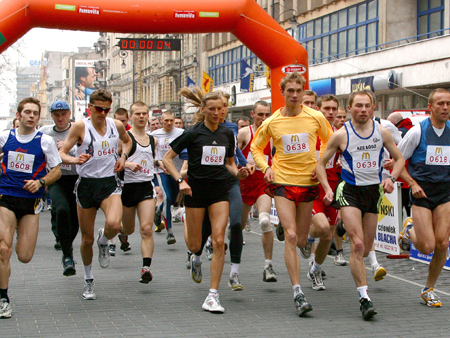
Astaxanthin Muscle Endurance & Recovery


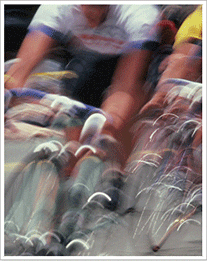
Work, Sport, Leisure – in fact all physical activity will generate free radicals; the more intense the activity the greater number of free radicals. Free radicals are shown to have damaging effects on muscle performance and recovery. Published and on-going research, focused on improving endurance and reducing recovery time, are showing dramatic benefits linked to the potent carotenoid - astaxanthin. These findings are bringing astaxanthin to the forefront as a dietary supplement for professional athletes and physically active people. Important to physical activity are our mitochondrial cells, often referred to as the “power stations of the cell” , which provide as much as 95% of our body’s pure energy (primarily by the burning of muscle glycogen and fatty acids). Unfortunately, a portion of this energy produces highly reactive and damaging free radicals. Free radicals damage cells by triggering peroxidation of the cell membrane components, and oxidation of DNA and proteins. Furthermore, free radicals continue to affect muscles even after the strenuous exercise has ceased. Free radicals activate the inflammation response whereby monocytes migrate into the muscle tissue causing additional cell damage. Often we will notice the onset of muscle damage during recovery in the form of tiredness and soreness. In addition to improving muscle performance through devised exercise regime, the sports research community is looking at other methods, such as nutrition to fuel and protect the body under extreme physical conditions. In the past, Vitamins E and C helped make the use of antioxidants a popular tool against oxidative damage during intense physical activity. Today, informed by current research we can point to astaxanthin as the anti oxidant of choice for sports performance.
Astaxanthin demonstrated two important physical benefits in clinical trials and supporting studies. Astaxanthin increased endurance and reduced muscle damage in animal models.
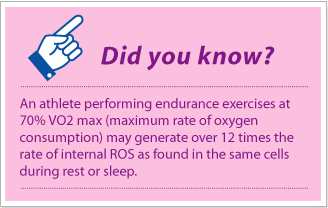
Endurance
In 1998, Malmsten (Karolinska Institute, Sweden) conducted a randomized, double-blind, placebo controlled study on healthy men supplemented with 4 mg astaxanthin per day for up to 6 months. Standardized exercise tests demonstrated that the average number of knee bends performed increased only in the astaxanthin treated group at three months, and by the six month significant improvements were observed (Figure 1). These findings suggest that astaxanthin increases our level of endurance. In addition, Sawaki et al., (2002) of Juntendo University, Japan demonstrated by using 1200 meter track athletes, that a daily dose of 6 mg per day for 4 weeks resulted in their bodies accumulating lower levels of lactic acid (Figure 2). Under strenuous activity, the formation of lactic acid is a result of anaerobic metabolism or a consequence of insufficient oxygen for muscle demand. Under these conditions, a lower level of lactic acid typically suggests improved endurance ability.
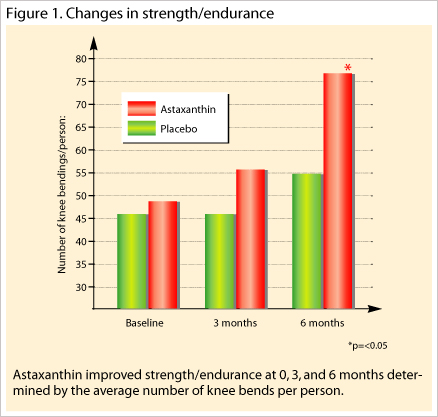
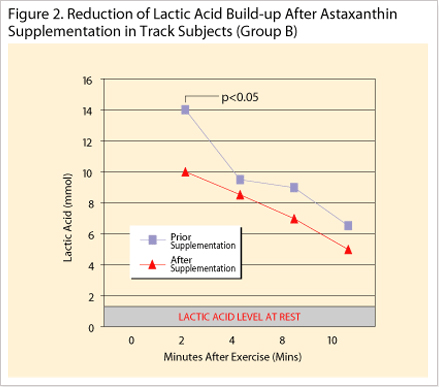
The Mechanism
The mechanism behind muscle endurance is based on several findings. Generally, astaxanthin protected the skeletal muscle from the increased damage of oxidative stress generated by physical activity. Furthermore, astaxanthin increased the metabolism of lipids as the main source of energy production by protecting the carnitine palmitoyltransferase I (CPT I) involved in fatty acid transport into mitochondria. Aoi et al., (2003) of Kyoto Prefecture University used mice models that may partially explain the efficacy of astaxanthin; they compared control, exercise placebo, and astaxanthin treated exercise groups after intense physical activity. 4-hydroxy-2-nonenal-modified-protein (4-HNE) stain analyses of the calf (gastrocnemius) muscles and heart (cardiac) muscles revealed significantly lower peroxidation damage (Figure 5). Other biochemical markers for oxidative damage and inflammation such as DNA (p<0.05), creatine kinase (p<0.05) and myeloperoxidase activity (p<0.05) were significantly reduced in the astaxanthin treated exercise group. These effects indicate that astaxanthin has a role in helping protect muscle cell components and down modulating the inflammatory processes. Lee et al., (2003) also explained that astaxanthin directly modulates inflammation caused by the release of the pro-inflammatory cytokines and mediators. In vivo and in vitro tests demonstrate that astaxanthin inhibits the IκB Kinase (IKK) dependant activation of the Nuclear Factor-kB (NF-κB) pathway, a key step in the production of pro-inflammatory cytokines and mediators. Aoi et al., 2008 also demonstrated increased lipid metabolism compared to carbohydrate as the main source of energy during strenuous activity (Figure 6). Furthermore, analysis of the mitochondrial lipid transport enzyme known as carnitine palmitoyltransferase I (CPT I) revealed an increased fat localization (Figure 7) and reduction of oxidative damage in the presence of astaxanthin (Figure 8). CPT I is important because it regulates fatty acyl-CoA entry into the mitochondria in the oxidation of fatty acids in muscle. Exercise-induced ROS may partly limit utilization of fatty acid via diminishing CPT I activity.
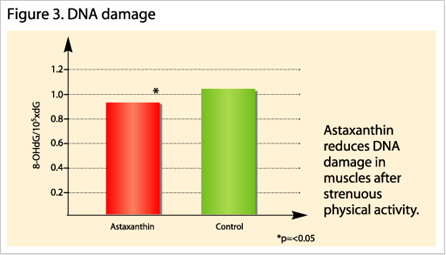
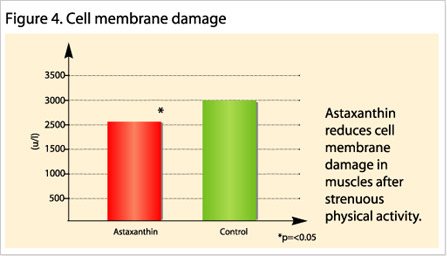
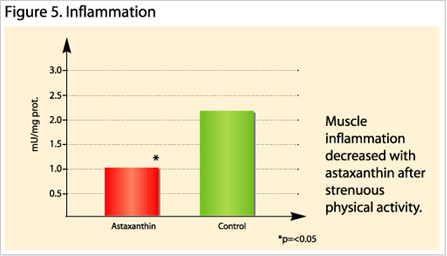
Outlook
Strenuous physical activity generates high levels of ROS which affect muscle performance and metabolism of lipids. New research shows that astaxanthin can modify muscle metabolism via its antioxidant effect, resulting in the improvement of muscle function during exercise. Therefore, astaxanthin is expected to be useful for physically active people as well as athletes.
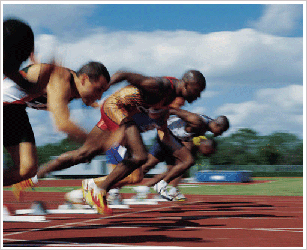
 References
References
1. Aoi, W et al. (2008) Astaxanthin improves muscle lipid metabolism in exercise via inhibitory effect of oxidative CPT I modification. Biochem. Biophys. Res. Com. 366 (2008) 892–897.
2. Ikeuchi et al. (2006) Effects of astaxanthin supplementation on exercise-induced fatigue in mice. Bio. Pharm. Bull. 29(10):2106-2110. 3. Aoi, W. et al. (2003) Astaxanthin limits exercise-induced skeletal and cardiac muscle damage in mice. Antioxid Redox Signal 5(1):139-144.
4. Sawaki, K. et al. (2002) Sports performance benefits from taking natural astaxanthin characterized by visual activity and muscle fatigue improvements in humans. Journal of Clinical Therapeutics & Medicine 18(9):73-88.
5. Malmsten, C. (1998) Dietary supplementation with astaxanthin rich algal meal improves muscle endurance - a double blind study on male students. Karolinska Institute, Stockholm (Unpublished).
6. Lee et al., (2003) Astaxanthin Inhibits Nitric Oxide Production and Inflammatory Gene Expression by Suppressing lκB Kinase-dependent NF-κB Activation. Mol. Cells, Vol. 16, No. 1, pp. 97-105.



